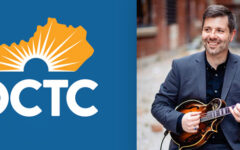
The fiddle chop is not a new technique in the bluegrass world. Since Bill Monroe made the mandolin chop such a primary part of the bluegrass ensemble, fiddlers had begun mimicking that percussive, rhythmic sound with the fiddle when the mandolin would drop out for a solo, or was missing from the band sound for any reason. Earl Scruggs brought a similar technique to the banjo, and now reso-guitarists also use it in their arsenal.
Innovative grassers like Richard Greene and Darol Anger have been stretching the use of the fiddle chop into a more versatile mechanism of expression on the fiddle for some time, particularly notable from Anger with the Turtle Island String Quartet.
But in the wider string music world, it is a bit of a foreign concept. Using the violin or cello to play extremely short, percussive beats with the bow aren’t unheard of, but no officially-accepted system of notation had existed for what has entered the realm through the music of cellists like Rushad Eggleston, or fiddler Casey Driessen. Classical and jazz percussionists are taught notation that is common within orchestral scores and jazz charts, or in show music, but instructors haven’t had a standardized method for teaching it for strings.
You can see an example of this sort of contemporary chop on video by Eggleston below. He was for several years the cellist with Crooked Still, who successfully mixed old time and bluegrass themes with a more modern sound.
Fiddler Casey Driessen, now an instructor for the Berklee College of Music in Spain, is another pioneer of this technique. He uses it in his live performances, often involving the creation of intricate loops in the moment, and in accompaniment playing with a more traditional string band.
Here’s an example.
Now Driessen has compiled his knowledge into a free e-book he has titled The Chop Notation Project, with co-author Oriol Saña, which seeks to provide both a history of the technique and a system of notation that he hopes will become widely accepted. With this in mind, they are giving away the 40 page digital booklet online, and encouraging fiddlers, violinists, and instructors of all stringed instruments to download and disperse it throughout their circles.
After a brief history of the chop, they introduce a Chop Notation Glossary so that players and instructors can have a common vocabulary for discussion, and some specific tips and tricks with the bow that should be mastered. Most of what is covered would be within the range of an intermediate student, and could be worked through with a teacher in a few lessons.
It would be a boon to the string world if this notation system was adopted and taught to young string students, especially those with an interest in contemporary or improvisational music of any kind. Plus it looks like lots of fun!
Casey has also shared this video where he demonstrates the terms and techniques of his Glossary, and provides an overview of what is shown in the book. The video is also available at no charge, and all are encouraged to use it.
Serious students who are interested in Casey’s playing can look into his video instruction series which follows the same themes of the e-book. Details on that can be found online.
You can download The Chop Notation Project on Casey’s web site.







